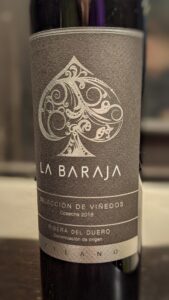Crouched down near the ground, a sharp pain went up his knees and lower back as weathered hands reached out to old grape vines, around 50 years old, to harvest the few bunches of concentrated Tempranillo grape bunches that looked like they hung on a skeleton of a bush plant with its thick, gnarly trunk. The sun beating down on top of his head forced his eyes to squint to combat the glare and the dirt on his face and hands lessened the brutal effects of the sun as he picked his precious fruit. His wife and children were there to help; his ten-year-old son already a seasoned harvester with his skill and speed; his parents, who were advanced in age, would still stubbornly insist on helping out even though many times they would only be able to get through a few vines by the end of the day – each vine only producing a relatively small amount of fruit.
It is not so unbelievable to think that a wine grape grower and his family would place such a tremendous amount of backbreaking work into their own vineyard which produced incredibly concentrated and well-balanced Tempranillo grapes but the true shock is that, for decades, it went into making bulk wine.
Ribera del Duero
Today Ribera del Duero is a famous wine region in Spain with such wine producers as Vega Sicilia and Pesquera who both helped to associate that wine region with outstanding red fine wines made from their native Tempranillo (called Tinto Fino in Ribera del Duero) grape and in Vega Sicilia’s case, a small amount of Bordeaux varieties blended in some bottlings. Bodegas Vega Sicilia has had a long history that goes back to 1864 which is quite impressive considering it survived the Spanish Civil War and 36 years of Franco’s dictatorship rule that, many times, targeted those Spanish people and citizens who were considered part of demonized elite class; serendipitously, Pesquera’s first vintage was 1975 – the year that Franco died. Francisco Franco was a man who didn’t drink much wine and he is said to have had no appreciation for it outside of it being an economic driver for Spain; this attitude led to the destruction of many vineyards, especially those producing white wines, and a demand for an enormous quantity for bulk red wine; he even outlawed artisanal cheese made by small cheesemakers.
And even though many of the old Tempranillo vines owned by generations of grape growers in Ribera del Duero were spared by staying under the radar during Franco’s rule, they were forced to sell the fruit off to bulk wine production; those precious grape bunches from those incredible old vines were thrown in with a mixed bag of grapes.
Spain as a whole still grapples with its past that involved Franco as he is thought by some as the man who brought order to a chaotic Spain and eventually brought the Spanish Miracle that started in 1959 (tremendous growth in Spain’s economy) as opposed to others thinking of him as a ruthless dictator who was responsible for the death, torture and destruction of many Spanish families that still carry the scars from Franco’s time even today. The iconic Spanish wine producer Miguel Torres talked about how his own father, Miguel Torres senior, was thrown into one of Franco’s concentration camps and still today, due to an agreement after Franco’s death to look only to the future, the amount of people he killed and locked away is still not known as the full impact of his destructive reign has not been completely recognized by Spain’s government; such avoidance of trying to fully make amends for the past, unlike what Germany has done in regards to the crimes against humanity of the Nazi party, has kept Catalonia’s bid for independence still alive as no other region suffered as much as Catalonia under Franco’s rule. Miguel Torres said that people still lived in fear for decades after Franco’s death as it was never clear if his way of ruling had ever left – many thinking that behind closed doors “Francoism” could still exist and hence why many had stayed silent about the atrocities committed against their own families until recently.
Bodegas Vilano
And so it makes sense, considering the history of Spain, why family owners of such extraordinary old Tempranillo vines would just keep their heads down and give away such valuable fruit to make cheap bulk wine under the surveillance of the government. But in 1957 ten grape growers in Ribera del Duero, with vines that were half a century old, decided to form a cooperative that eventually took the name of Bodegas Viña Vilano so they could pool their resources to make and sell their wines themselves. Of course it was still risky at the time to do anything that way seen as the creation of a premium product and so they sold their wine as regular table wine which was only a few steps up from nationalized bulk wine.
But in 1999, with around 80 local grape growers becoming part of the cooperative, as well as witnessing how well-received other Ribera del Duero wine producers had become for making fine wine, they invested in state of the art winery equipment and quality barrels to raise the quality of their wines while also changing the name to simply Bodegas Vilano.
Today the grandchildren of those growers still farm their own small plots of vineyards while producing more premium offerings that range from Roble, Crianza and Reserva Tempranillo wines that are sold domestically but a couple of “Signature” bottlings of fine wine, that express the special qualities of their old vines, have made their way to the U.S. market: Terra Incognita and La Baraja.
Terra Incognita is a selection of the oldest vines among the members, vines which range from 80 to over 100 years old – many of the original ten members’ vines were already 50 years old in the mid-1950s; and La Baraja, which is the only blended wine of Bodegas Vilano as all of their red wines are 100% Tempranillo like the Terra Incognita, is a blend of 75% Tempranillo from 70-year-old vines and 15% Cabernet Sauvignon and 10% Merlot that comes from 35 to 37 year-old vines – La Baraja is from a single vineyard called La Baraja and so it is only made in the best years for this vineyard.
Symbiotic Relationship in a Wine Region with Icons
The easiest thing for any leader to do is blame bad times on a particular group – a strategy that has been used many times throughout history with tragic consequences; contrasted with great leaders who take the difficult path of doing what is right for the country as a whole which involves taking full responsibility for the ups and downs of people’s livelihoods even when the reality of life is that many things, such as national economies, cannot be controlled by one person or even one government – some cycles in life are beyond direct human control.
And through time, the benefits of these iconic producers in Ribera del Duero are being realized; as they have gambled with their own money and took on a stressful amount of overhead, they have made it possible for the old vines of these family farmers to be appreciated for the great wines that they are able to produce. Many of the current members of Bodegas Vilano know that their grandparents could have never imagined that their vines would be so greatly respected nationally, let alone globally.
And so when a grandson goes into the vineyards like his grandparents did, it is still the same sun that beats on his head, the same dirt that covers his face and hands and the same vines that have just gotten thicker, more gnarly trunks over time but there is one big difference – instead of it being soul-crushing work with no future, no hope and no value, it is now a fulfilling task of being a part owner of a company that is making your grandparents’ long cherished grapes into a thrilling fine wine that is appreciated as something rare and special around the world.
***This article was originally published on Forbes: https://www.forbes.com/sites/cathrinetodd/2021/12/31/wine-grape-growers-take-leap-to-make-fine-wines-in-a-spanish-wine-region-dominated-by-icons/?sh=2e4d75ac2d1d
2019 Bodegas Vilano, ‘Terra Incognita’, Ribera del Duero, Spain: 100% Tempranillo (called Tinto Fino in Ribera del Duero) ranging from vines 80 to over 100 years old. Rich, brooding dark fruit flavors and hints of cocoa powder that had a fleshy entrance that was accompanied by more fine tannic structure mid-palate and great precision on the finish with a lifted orange peel note.
2016 Bodegas Vilano, ‘La Baraja’, La Baraja Vineyard, Ribera del Duero, Spain: 75% Tempranillo (called Tinto Fino in Ribera del Duero) from 70-year-old vines and 15% Cabernet and 10% Merlot from 35 to 37-year-old vines. A lovely mixture of blackberry and red cherry fruit with an added complexity of fresh leather and crushed rock aromas in the background with lace-like tannins that knitted together good concentration of fruit on the palate; an elegant and powerful wine all at once. Since La Baraja is from a single vineyard called La Baraja, it is only made in the best years for this vineyard and so the next vintage will not be until the 2019 is released after aging.

















